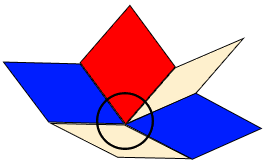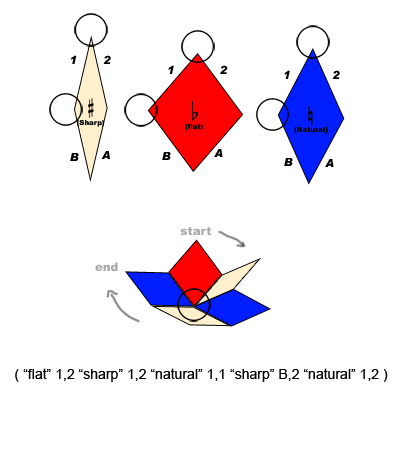The biggest difficulty in creating a non-computer reliant version of this game has been in the incorporation of a meaningful end-game condition.
In class, it was apparent that the game lacked a strong enough connection to the philosophy that the game is supposed to model. To fix this I've come up with an idea, but its incorporation into the game initially appears very difficult.
The idea would change the goal of the game from winning points (never seriously considered) to ordering the board, which would bring the focus of the game to the two main concepts of the philosophy: creating order by finding connections. The difficulty is that this could make the game very frustrating, or impossible. It also ruins the idea of having a "print-out" of the game board since the board would be changing.
The idea (still in cloudy form):
In the current rules (see below), finding a connection (same ratio symbol as opponent) gives you a point and gives you your opponent's bead. In this idea, instead of getting their bead you would get the symbol under their bead. Acquired symbols would be like a player's bag of tricks; if an opponent puts a bead on a space that has a unique ratio (or whatever the "connecting" criteria is), the player might be able to place their symbol back onto the board in such a way that it creates a connection for them.
Theoretically this works wonderfully, and philosophically it's solid as solid can be, but the nitty-gritty rules that make it work could be very confusing or difficult to satisfy in-game. I can see this addition to the game making the game last forever, which is good and bad; good because that's accurate to the book--the games could go on for weeks--and bad because it might dissuade people from playing.
*tangent: if this is the case, and the game lasts forever, an internet version of the game would be ideal. I'm thinking about those flash games where 100's of people try to spell a word on a virtual refrigerator door. Similarly, the game might be played in real time, with the board changing and pieces flying everywhere, the goal being to create your own patterns, or to create one pattern cooperatively.*
I suppose the next step is to try out this idea and work out the nitty-gritty rules of it.
Wednesday, January 30, 2008
Monday, January 28, 2008
Basic Game Rules *trumpets sound*
Basic Game Rules:
Setup:
-take 7 of each of the three shapes and make a small, 21 piece mandala (14 sided polygon). For example:

-player 1 starts with 4 dark beads
-player 2 starts with 3 light beads
-player 1 goes first
first round:
-player 1 places a bead on any intersection on the board

-player 2 places a light bead on an open intersection on the board, attempting to match player 1’s ratio of shapes (in the example above, the ratio of player 1’s intersection is 2/2/1 because it has two blue, two white, and 1 red shape). An exact match doesn’t count.
-if player 2 is successful, they take the bead of their opponent off the board and into their own hand. The space in which the bead sat cannot be used for 1 turn (note, this rule can change in larger versions of the game to say that the space cannot be used for the rest of the game). Player 2 gets a point.
-if player 2 is not successful, no beads are taken away and nobody gets a point. It becomes player 1’s turn again. Player 1 will then do the same as player 2, attempting to match player 2’s intersection ratio.
Strategies and other things to note:
-if a player puts a bead down and their opponent has multiple beads on the board with that same ratio, the player will take all of their opponents beads that match that ratio, and gain 1 point for each capture.
-captured beads are playable and they work in play as if your opponent had played them—any captured beads (captured beads will be your own color) will go to your opponent and your opponent will gain 1 point for any bead you capture for them.
-At the end of the game—when a player has run out of beads—any remaining beads in hand will be counted as either 1 point gained or subtracted (for every bead of your opponent you lose 1 point, for every bead of your own you gain 1 point). The player with the most points wins.
pattern notation
I've come up with a weird pattern notation scheme that can be used to record played patterns in the game. It's a bit hard to explain in words, so I'll make a diagram:

The three different shapes are labeled "sharp" "flat" and "natural" (referencing music notation). The four sides of each shape are labeled 1, 2, A, B going clockwise. The position of the bead determines where the starting point is, as pictured in the diagram.
Weee fun fun fun

The three different shapes are labeled "sharp" "flat" and "natural" (referencing music notation). The four sides of each shape are labeled 1, 2, A, B going clockwise. The position of the bead determines where the starting point is, as pictured in the diagram.
Weee fun fun fun
Sunday, January 27, 2008
brainstrom
This past week I've been brainstorming like mad. My notebook is half full with just about every idea I've had for this game, arranged in a manner that makes it completely inaccessible. However, in doing this I've really solidified the philosophy behind this game, and entertained a huge number of possibilities in gameplay that I may use later as I begin developing more versions of the basic game.
Writing this is hindsight is a bit weird considering I know the future. Should I whinge on about how I'll never come up with this blasted "basic game," or should I tell my past self that it will all come to pass; that yes, you will come up with a basic game that could possibly incorporate these ideas you are having, that it will all be ok and Jon won't fail you? Well, still waiting on that one...
please don't fail me.
In other news, I came up with a strange way to get myself into action in my depressed state. I pretend I'm someone else and do what they would do in my situation. I pretended I was a girl named Aubrey. She's a go-get-'em type with big ideas, big dreams, and a big capacity to plow through loads of exhausting work. It's not exactly that I pretend I'm this person, but I think it sounds funnier if I just leave it at that...
*turns into Aubrey*
toodles :)
Writing this is hindsight is a bit weird considering I know the future. Should I whinge on about how I'll never come up with this blasted "basic game," or should I tell my past self that it will all come to pass; that yes, you will come up with a basic game that could possibly incorporate these ideas you are having, that it will all be ok and Jon won't fail you? Well, still waiting on that one...
please don't fail me.
In other news, I came up with a strange way to get myself into action in my depressed state. I pretend I'm someone else and do what they would do in my situation. I pretended I was a girl named Aubrey. She's a go-get-'em type with big ideas, big dreams, and a big capacity to plow through loads of exhausting work. It's not exactly that I pretend I'm this person, but I think it sounds funnier if I just leave it at that...
*turns into Aubrey*
toodles :)
Tuesday, January 22, 2008
Depression sets in
Yes. Depression, my old friend, has returned at a most opportune time.
Can't get out of bed, can barely stand to think about anything at all, but when I try meditating I can't stop thinking. Can't sleep. Can't do work, even if it's due, which has always been something to kick my ass into gear. How will I ever complete this semester with all this independence?
How!?
Can't get out of bed, can barely stand to think about anything at all, but when I try meditating I can't stop thinking. Can't sleep. Can't do work, even if it's due, which has always been something to kick my ass into gear. How will I ever complete this semester with all this independence?
How!?
Game distribution
I've been thinking about how I would like to distribute this game, and I think Joe gave me a good direction in class the other day.
Rather than making a complete Flash Version of the game, or asking people to buy the pieces from Fractiles, I could make a simple construction set where people could arrange a new board, print it out, and play. Assuming I come up with a game for them to play...
Rather than making a complete Flash Version of the game, or asking people to buy the pieces from Fractiles, I could make a simple construction set where people could arrange a new board, print it out, and play. Assuming I come up with a game for them to play...
game development
still in development.
I would have liked to have the game concept completely flushed out by now, but the last element of the game still eludes me. I've come up with about a billion variations, but most of them play more like a process piece than a game. Right now I'm focusing on how I can make this a fun game but still firmly attached to the philosophical concepts it illustrates whilst implementing a simple, unique and almost entirely new style of gameplay.
Repeatedly, I've come to the question of what the "goal" of the game is, because it certainly isn't whoever-gets-the-most-points-wins or any other typical game condition I can think of. Recently though, I came up with the idea to have the game conclude in a place where it can begin again, making the game into a sort of circle.
I think I need to pretend I know how the game works completely, and just play it most to see where the faults are.
I would have liked to have the game concept completely flushed out by now, but the last element of the game still eludes me. I've come up with about a billion variations, but most of them play more like a process piece than a game. Right now I'm focusing on how I can make this a fun game but still firmly attached to the philosophical concepts it illustrates whilst implementing a simple, unique and almost entirely new style of gameplay.
Repeatedly, I've come to the question of what the "goal" of the game is, because it certainly isn't whoever-gets-the-most-points-wins or any other typical game condition I can think of. Recently though, I came up with the idea to have the game conclude in a place where it can begin again, making the game into a sort of circle.
I think I need to pretend I know how the game works completely, and just play it most to see where the faults are.
Tuesday, January 15, 2008
Subscribe to:
Posts (Atom)

